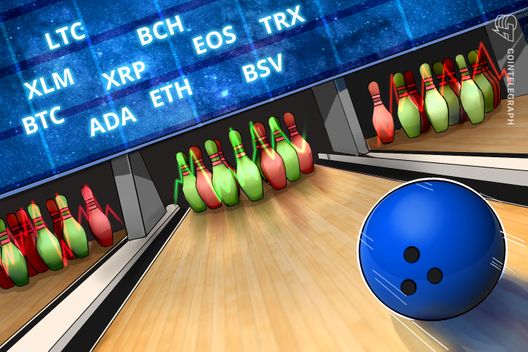Bitcoin Price Rally by 2021 Looks Likely From Five Fundamental Factors
The price of Bitcoin (BTC) has been bouncing in the range between $8,600 and $10,000 for the past two months. BTC has shown little volatility since May, following a critical rejection at $10,440. However, five major fundamental factors still point toward a prolonged uptrend by 2021.
According to data from Skew, the 10-day realized volatility of Bitcoin dropped to the lowest level of the year on June 24. This may indicate that traders are cautious because BTC is at a crucial price point. The performance of BTC over the next several weeks could hint at its price trend throughout the year’s end.

Generally, the sentiment of cryptocurrency traders on the medium-term outlook of Bitcoin remains positive. In the short term, analysts see weakness in BTC and other leading cryptocurrencies due to external variables like the COVID-19 pandemic.
Over the long run, strong macro factors suggest BTC is on track for a firm recovery. The most prominent piece of data that supports predictions of a positive trend is the increase in “HODLing” activity among investors.
Heavy accumulation of Bitcoin
According to Rafael Schultze-Kraft, the chief technical officer at Glassnode, various HODLing data shows a rise in investor confidence. To start with, Bitcoin’s supply that has not moved for over a year has hit an all-time high, standing at 61%. It demonstrates the lack of appetite to sell BTC at the current price level. Shultze-Kraft said:
“First, the obvious one: 61% (!) of Bitcoin supply that hasn’t moved in over a year — that’s an all-time high. Moreover, 44% hasn’t moved in 2+ years (approaching ATH), and almost 30% hasn’t moved in 3+ years. Loads of hodling here.”

Shultze-Kraft further emphasized that a metric called “HODLer Net Position Change” shows investors accumulated Bitcoin heavily in 2020. The data portrays the unwillingness of many retail investors to sell BTC, noting that: “There have been only 16 days since the beginning of this year, in which the BTC Hodler Net Position Change has been negative.”
If the BTC HODLer net position change remains positive, it means that investors are not moving funds from personal wallets to exchanges to sell. In March 2020, the price of Bitcoin dropped below $3,600 on several major futures exchanges.
Altana Digital Currency Fund chief investment officer Alistair Milne suggested that if this drop could not shake investor confidence, there are not many factors that could in the future. Milne stated: “Similar levels of HODL last seen during a 3-month consolidation at around $400 before starting a two year bull run […] Guesstimate that this cycle will peak around 70%?”
Historically, bull runs in the cryptocurrency market coincided with an increase in HODL activity. At the start of 2018, for instance, the “HODL Wave” of Bitcoin started to rebound. From March to July of that year, BTC rose from around $4,000 to $14,000.

As such, Philip Swift, the creator of cryptocurrency market data platform lookintobitcoin.com, stated: “Such high levels of HODLing have been present at the start of previous Bitcoin bull runs.”
Institutional investors consistently invest in Bitcoin
From March 2020, the assets under management of the Grayscale Bitcoin Trust rose from $1.577 billion to $3.541 billion. The sharp increase in AUM suggests a similarly accelerating demand from institutional investors.
Most specifically, United States institutions have a narrow selection of investment vehicles that can be used to gain exposure to Bitcoin. Without an exchange-traded fund, the Grayscale Bitcoin Trust is likely to remain the go-to vehicle for institutional investors.
The AUM of the Grayscale Bitcoin Trust hitting an all-time high, while the price of Bitcoin is down by more than 50% from its record high is a positive metric. This shows that institutions have confidence in the long-term trend of BTC, and more than they did three years ago.
But, according to Messari researcher Ryan Watkins, reports of Grayscale buying most of the Bitcoin that is newly mined can be inflated. Watkins explained that Grayscale only bought 31% of newly mined Bitcoin since the May 11 halving:
“Grayscale buys way less Bitcoin than many would think. Factoring in ‘in-kind’ purchases, Grayscale has only bought 31% of all new Bitcoins mined since the halving, far less than the 150%+ many have reported. This is just one of many misconceptions about Grayscale’s trusts.”
While analysts note that it is critical to consider numbers that could potentially amplify the actual figures of the trust, accumulating 31% of mined Bitcoin is still a substantially high number.
Optimistic technical structure
Nunya Bizniz, a cryptocurrency trader, said that the six-month chart of Bitcoin is set to see a Green 1, or G1, candle under the Tom Demark Sequential Indicator system. Each time a G1 candle appeared, Bitcoin saw a prolonged upsurge for several years. The trader also said: “A Green 1 candle signals the start of an upward trend. The six month candle will close today as a G1. Bull run ahead?”

Along with several favorable technical structures and macro indicators, futures data also indicates that the market is not overbought. Typically, when the price of Bitcoin sees a large correction, it is triggered by the capitulation of overleveraged buyers. On futures exchanges like BitMEX, buyers often borrow capital with a leverage of up to 100x to place a long contract on Bitcoin. If BTC drops, it can cause a cascade of liquidations and an abrupt price fall.
A technical analyst known as “Byzantine General” said the funding rate of the perpetual swap contract of BitMEX and open interest show that BTC is not overbought just yet. They said: “At the peak of the last rally in February, there were a lot of very clear signs that the market was overleveraged and overbought. But at the moment we don’t really have that.”
Possibly due to the optimistic medium-term trend of Bitcoin, there was an increase in the number of high-net-worth investors moving funds off exchanges to personal wallets in recent months.
The number of whales in the Bitcoin market has surpassed 1,800, based on data from Glassnode. But, given that the amount of BTC held by whales did not increase, it suggests the BTC market became less concentrated with new entrants.
Rising hashrate brings all macro factors together
When the May 11 block reward halving occurred, analysts anticipated the hashrate of the Bitcoin blockchain network to fall sharply, since the event caused the amount of BTC mined to drop by half, thereby decreasing the revenues of most miners by up to 50% overnight.
However, data from Blockchain.com shows that the hashrate of Bitcoin has recovered close to pre-halving levels. The mining industry remains healthy despite the halving, which might further brighten the sentiment around Bitcoin overall.
The large mining centers based in Sichuan, China, remain largely profitable. The rainy season caused electricity rates to drop, reducing the cost of mining BTC. Consequently, miners have less incentive to sell large amounts of BTC in the near-term to cover costs. Typically, overleveraged miners are pressured to sell after halvings as the cost to mine Bitcoin spikes. This time around, the block reward halving was met with relatively low selling pressure.
Therefore, a confluence of low selling pressure from miners, favorable long-term technical structure, increasing HODLing activity, a growing number of whales and rising institutional adoption raise the probability of a newfound rally by 2021.









